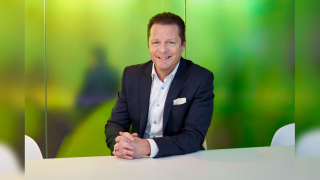The round-trip delay between Asia and western Europe will come down by about 100ms to just 142ms if a new 14,500km fibre is laid across the Arctic Ocean and northern Canada.
At the moment, as Asian carriers know only too well, the journey to and from partners in western Europe is long and meandering: head south from Japan and South Korea, through a narrow gap between Sumatra and the Malay Peninsula, around India, along the tightest channel of them all, the Red Sea, and across Egypt and into the Mediterranean, before landing on Europe’s south coast.
But it does not have to be this way. Look at a globe in any schoolroom, and you will see the quickest path is over the top, through the Arctic Ocean. This is the proposed course for Far North Fiber (FNF).
“Far North Fiber is a route greatly reducing the optical distance between Japan and western Europe, relative to all other combinations of terrestrial and oceanic fibre plant available today. The route minimises signal latency to an unrivalled 142ms round-trip delay,” Ethan Berkowitz, FNF’s president, informs me from Anchorage, Alaska.
Compared to the typical ping time between London-Tokyo of 243ms (as measured on 1 November), FNF’s service would be a full tenth of a second faster.
Berkowitz is a Californian lawyer who received a Master of Philosophy in Polar Studies from Cambridge University’s Scott Polar Research Institute. Afterwards, he moved to Alaska, where, 25 years later, he became the mayor of Anchorage and interested in telecoms. He co-founded a company that developed a terrestrial cable system running to Prudhoe Bay on Alaska’s north coast.
So, building a Northwest Passage for telecoms is close to his heart. But the FNF project will be expensive, at an estimated cost of US$1 billion.
Telecom’s Northwest Passage
Seamen had known about the original Northwest Passage for many years, but many failed, sometimes tragically, before a route between Asia and Europe through the open, frozen, water around Greenland and northern Canada was found. But one of the consequences of the climate change disaster is that it may soon be possible for ships to travel safely through the Arctic Ocean’s coastal waters.
Subsea cable developers have had the same idea. A few years ago, Cinia, a Finnish company, talked to Megafon, a Russian operator, about laying a subsea cable through the Arctic via Russian territorial waters. Russia’s invasion of Ukraine, and the subsequent greater awareness of security risks, mean this project is likely no longer feasible.
Around the same time of Cinia’s and Megafon’s discussions, Quintillion, a Canadian company, was looking at extending a cable it had built around Alaska south to Japan and also east to Ireland via Canadian waters. Quintillion’s subsea cable links Prudhoe Bay to Alaska’s coastal communities, including Nome and Kotzebue on its west coast.
More recently, Alaska has become a centre of expertise in laying fibre through frigid waters, with Liberty Broadband’s GCI completing the AU-Aleutians Fiber Project in October 2022. This connects the state’s Aleutian Islands to the mainland, and promises the islands’ residents 2Gbps fibre-to-the-home (FTTH) services.
Berkowitz has been watching such projects for some time, he tells me. “[FNF] was looking at a proposal to wrap cable round the coast of Alaska, linking hundreds of villages. We realised we might as well continue to Europe and to Asia.”
Since then, “we’ve formed the relationship with Cinia, and that’s been instrumental in setting up the Northeast Passage project”, he says. A Northeast Passage? Well, it is, if you’re starting from Alaska and heading to Europe.
Heading further west from Alaska’s coast, the logical next step is Japan, where FNF’s partner is Arteria Networks, a subsidiary of Marubeni. Arteria has a fibre network around Japan and signed a memorandum of understanding with Cinia in late 2021.
“We’ve good friends in high places,” Berkowitz says, smiling. “This is an incredibly viable project. The project has a proven team in place.”
Earlier subsea projects around Alaska have given the subsea world experience in working in Arctic seas. “We’re bringing familiar technology to the environment,” he adds.
In October, FNF said that it has selected Alcatel Submarine Networks (ASN), which is owned by Nokia, to build and install the submarine cable and equipment required for the project. The cable should be ready for service “by the end of 2026”, says FNF. Berkowitz agrees with this date, and adds that FNF “had a pre-existing relationship” with ASN.
Close to the coast
Much of the length of FNF’s planned 14,500km fibre will run close to the coasts of Alaska, Canada and Greenland. So while subsea is the only way to cross the 2,800km stretch between Japan and the Aleutian Islands’ western tip, why not build a terrestrial cable for the rest, I ask.
“In Canada it would be a nightmare to acquire the permissions. It would be a regulator’s dream. And it is much easier and much safer to go underwater,” Berkowitz explains.
In addition, laying cable under ice has its benefits. “The ice is a shield. It protects the cable,” he says.
Suvi Lindén, a former telecoms minister of Finland, said this to my colleague Natalie Bannerman, deputy editor of Capacity magazine, four years ago.
“Once the cable is built and the weather freezes over again, there’s actually a lower risk of it being damaged because nothing can get to it. So, in a way, there’s a higher risk when there’s no ice,” Lindén said.
Others in the industry have made similar observations. Although, they have also pointed out that it can take many months to send a repair ship, if there is a fault at the wrong time. At this time of year, the middle of the Arctic winter, for instance, ice will not clear for months.
“The maintenance risk of winter is minimal,” says Berkowitz. “The ice protects the cable. And we’re developing some fast response capacity.” This is thanks to the oil and gas industry, he says, “which operates in the Arctic year-round. They’re people who understand the problem. We’re having conversations right now, to flesh out our plans”.
The company that owns FNF’s new cable running from Asia across the Arctic and into western Europe would be a carriers’ carrier, says Berkowitz. “We’re a long-haul company, operating dark fibre.” However, FNF’s partners have looked at “various scenarios”. According to the FNF’s announcement in October, two fibre-pairs out of 12 will be reserved for local use, carrying 30Tbps. The other 10 will carry a total of 120Tbps.
What’s the next stage in FNF’s ambitious project? “We’ve a rough idea of where we’re going,” says Berkowitz, “but we need a desktop and then a marine survey.”
FNF’s president emphasises that the company’s “focus is the cable” and that data centres and the like are the responsibility of others, such as Far North Digital.
A member of the FNF consortium, Far North Digital, plans to build a 120MW data centre in Prudhoe Bay, within the North Slope oil and gas field, that will be powered by locally supplied natural gas “using fuel cells and CO2 capturing technologies”.
The company notes that the “Arctic climate offers an abundance of server cooling without the need for inefficient HVAC systems”.
Berkowitz says that FNF will not need state aid, at least “not at this point”. But he adds that the company is “not reliant on it”.
Ireland, Finland and Norway
At its European end, FNF will terminate in a number of places, Berkowitz says. There will be a fork to Ireland, because “it’s close”, and another to Scandinavia, although the consortium is wavering on whether this should land on the north coast of Finland or Norway.
“We’re also looking to do branching units along the way for Alaska and Canada,” and Berkowitz adds that FNF is “looking at doing a dual landing in Japan, north and south”.
Berkowitz is confident that building the FNF cable will face few issues. “The Arctic is seismically stable,” he says, and other than that non-problem, “there are engineering problems that have an engineering solution”.
Berkowitz ends our interview on an optimistic note. “I want to underscore how exciting this is, to bring people together, especially when the world is incredibly divided,” he says. “We’re connecting three continents directly.”






